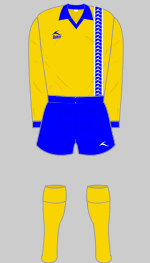Kit History
Southport
1881
Wound up in 1886

1881-1884 a
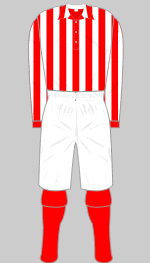
1884 a n
Southport Wanderers
1884
Changed name to Southport Sept 1886

1884-1886 a v
Southport Central
1888

1888-1904
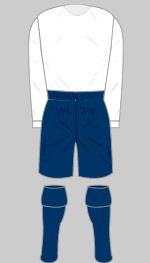
1904-1905 a n

1907-1909 a p

1916-1917 a t
Southport Vulcan
1918
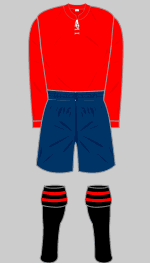
1918-1919 a
Southport
1919

1919-1921 a

1921-1922 a n
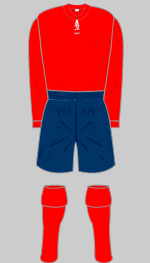
1922-1923 q
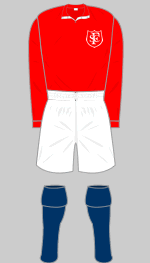
1923-1925 a m n s
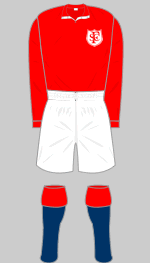
1925-1926 n
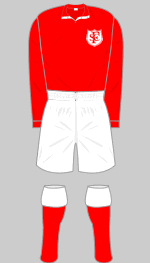
1926-1927 a n
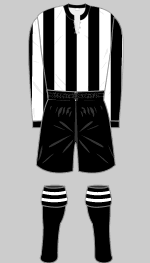
1927-1928 l n
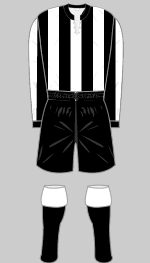
1928-1929 r
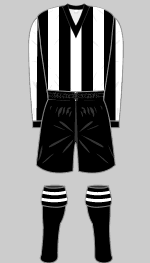
1930-1931 a f
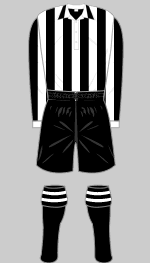
1936-1937
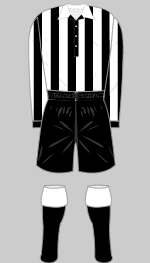
1937-1938 e
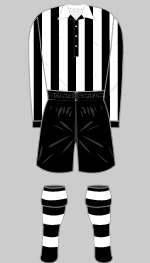
1938-1939 a n
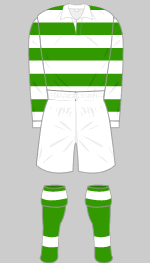
1944-1948 b h n
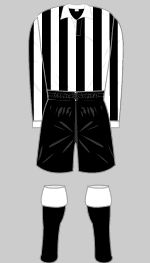
1948-1952 m
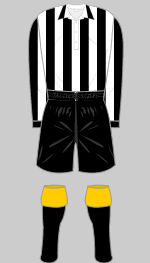
1952-1954 a h
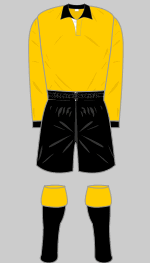
1954-circa 1957 a k
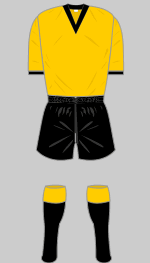
1958-1959 o
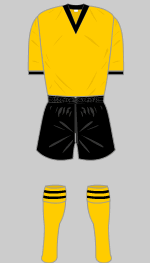
1959-1965 a n
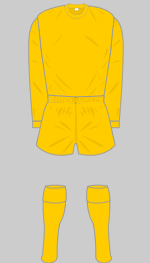
1965-1970 c h m n

1970-1971
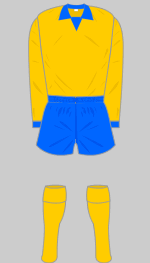
1971-1975 h i
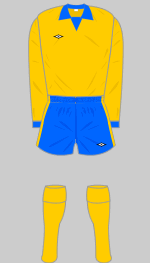
1975-1976 j
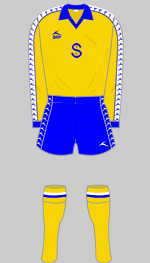
1977-1978 g j u
Background
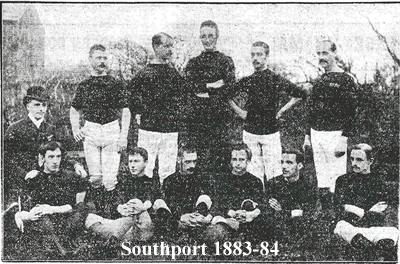 The elegant West Lancashire seaside resort was booming
in the late Victorian period where both rugby and association clubs sprang up.
The elegant West Lancashire seaside resort was booming
in the late Victorian period where both rugby and association clubs sprang up.
The original Southport FC started out as a rugby club but switched to the association code in November 1881 and wore red jerseys with white knickers. This club was wound up at the end of the 1885-86 season when several of their players transferred allegiance to local rivals Southport Wanderers. (Despite the fact that the two clubs co-existed for two seasons, Southport historians consider both to be antecedents of the modern club.)
Wanderers changed their name to Southport FC on 28 September 1886, inheriting the older team's representative mantle. The team won the Liverpool & District (Junior) Cup, their first regional honour.
In 1888 the club was reconstituted as a professional outfit to be known as Southport Central and became founder members of the Lancashire League in 1889, winning the title in 1903 when they made an unsuccessful application to join the Football League (receiving just four votes). Since the Lancashire League folded that year, Southport joined the Lancashire Combination for the 1903-04 season before becoming founder members of the Central League in 1911.
Southport have played at Haig Avenue since 1905. Details of the team's colours for this period are sketchy, the club's archives having been lost. In September 2017, however, we were able to confirm that the team played in red and white hoops and white knickers in the 1908-09 season.
During the First World War, Southport Central were invited to play in the Lancashire section of the wartime Football League.
In 1918 the club was taken over by the mayor, Councillor T Hampson, the owner of the Vulcan Motor Company in the north part of the town. In what is probably the first sponsorship arrangement of its kind, the club's debts were paid off and the team played as Southport Vulcan for one season. The arrangement was cut short, however, when Vulcan Company withdrew their support and shortly afterwards Cllr Hampson was sentenced to 12 months imprisonment for fraud. Thanks to the support of other council members, the club survived and was reorganised as Southport FC, with membership of the reconstituted Central league.
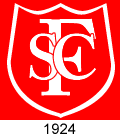 Two years later
Southport were elected to the new Third Division (North). Little impact was
made although the Sandgrounders (traditional nickname for natives of the
town)
Two years later
Southport were elected to the new Third Division (North). Little impact was
made although the Sandgrounders (traditional nickname for natives of the
town) 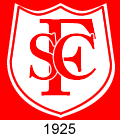 managed fourth place in 1925 and 1939. They were more frequently
in or near the re-election zone. A crest was worn between 1924 and 1927, an unusual departure for such a lowly team. It consisted of the letters "SFC" intertwined on a shield: the lettering was reversed out between 1925 and 1927. The rather peculiar appearance of the collars is probably due to the white tape on the inside of the fly being exposed when the laces were removed.
managed fourth place in 1925 and 1939. They were more frequently
in or near the re-election zone. A crest was worn between 1924 and 1927, an unusual departure for such a lowly team. It consisted of the letters "SFC" intertwined on a shield: the lettering was reversed out between 1925 and 1927. The rather peculiar appearance of the collars is probably due to the white tape on the inside of the fly being exposed when the laces were removed.
In 1927, in an attempt to improve the club's fortunes, the traditional plain red shirts were replaced by black and white stripes. The shirts featured V necks at one stage, very unusual for the time.
During the Second World War, the club lacked the clothing coupons to
replace its playing strip and for several years turned out in a green
and white hooped kit donated by one of the directors. In 1954 old gold
and black was adopted, previously their change strip. These changes did
little to revive the club's fortunes: 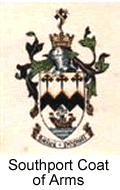 re-election three times in succession
between 1958 and 1960 marked the low point in a depressing decade.
re-election three times in succession
between 1958 and 1960 marked the low point in a depressing decade.
For many years the Southport coat of arms was used as the club's official crest but this only ever appeared on official documents and never on the team shirts.
Things improved dramatically in the mid-Sixties when the ex-Everton and Northern Ireland international Billy Bingham took over as manager and led the team, now in plain old gold, on a dramatic FA Cup run that took Southport to the Fifth Round. Fire destroyed the club's dilapidated wooden grandstand, purchased from the Southport Flower Show in the early years of the century, on the evening of Boxing Day 1966. Although the team kits and club archives were all destroyed, the safe containing the takings from that afternoon's match with Wrexham survived albeit fused shut. A temporary stand was quickly erected and a Fire Disaster Fund launched with a target of £70,000. The local public displayed their usual indifference and the appeal was wound up a year later having raised just £10,000.
Despite this set back, Bingham's golden boys won promotion for the first time ever at the end of the season and were presented with a special trophy by the comedian, Eric Morecambe. In August 1968 a smart, modern replacement stand with cantilever roof was officially opened although the rest of the ground fell into disrepair and eventually much of it was demolished.
In 1970 the Sandgrounders were relegated back to Division Four
but three years later, with ex-player Jimmy Meadows as manager, the club 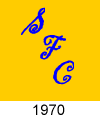 won the Fourth Division title, their only senior honour.
won the Fourth Division title, their only senior honour.
The 1970-71 season saw a subtle change to the team's colours with a small monogram embroidered in blue on the otherwise plain old gold shirts. Blue collars and shorts were introduced the following season, a departure from 'Port's traditional old gold and black.
The following season brought the beginning of a decline that took the
club out of the League. Their best players spent the summer in the North
American Soccer League (NASL) to supplement their wages and returned jaded
while Meadows was sacked in December 1973 after his attempts to strengthen
the squad on a shoestring failed. Relegation became inevitable. The experienced
Alan Ball Snr was drafted in as manager but his main interests lay with
Swedish club IF Saab and he neglected 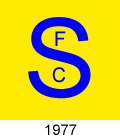 Southport disgracefully. In 1978
the 'Port faced re-election for the third season in succession and the
eleventh time in their history. After the chairman failed to canvas, Southport
tied with Wigan Athletic on the first ballot and were decisively defeated
on the second. In this, their last season in the Football League, an uninspiring "SFC" badge was worn in the centre of the now yellow shirts.
Southport disgracefully. In 1978
the 'Port faced re-election for the third season in succession and the
eleventh time in their history. After the chairman failed to canvas, Southport
tied with Wigan Athletic on the first ballot and were decisively defeated
on the second. In this, their last season in the Football League, an uninspiring "SFC" badge was worn in the centre of the now yellow shirts.
Because of the cost involved in traveling, Southport declined an invitation to join the new Alliance Premier League (forerunner of the Conference) and joined the Northern Premier League instead. Gradually the club overcame crippling debt and achieved a degree of stability on and off the field. They have spent several spells in the Conference Premier division and a return to league football remains the goal.
Sources
- (a) Official History of Southport FC
- (b) Hull City FC - Images of Sport
- (c) Port Pie
- (d) Exeter City FC - Images of Sport (Dave Fisher & Gerald Gosling)
- (e) Scarborough FC - Images of Sport (Paul Eade 2002)
- (f) One Hundred Years of Goodison Glory (Ken Rogers 1992)
- (g) Ralph Pomeroy
- (h) Pete's Picture Palace
- (i) Football League Review provided by Simon Monks
- (j) Alick Milne
- (k) John Mayall
- (l) www.penmon.org - the biography of George Harold Beadles
- (m) Keith Ellis (HFK Research Associate)
- (n) Port Online - superb unofficial history of the club.
- (o) Tony Sealey
- (p) "The 'Gate - A History of Shaddongate United FC" - Jon Tait (2017)
- (q) Athletic News (19 February 1923) submitted by Kingsley (Wrexham FC)
- (r) Stephen Paramore
- (s) Derbyshire Times & Chesterfield Herald (1 November 1924) submitted by Richard Essen.
- (t) Simon Monks
- (u) Halifax Courier (15 August 2019) submitted by Mark Alton
- (v) Charles Alcock's Football Annuals 1869-1891 researched by Robin Horton
Crests are the property of Southport FC. Photograph courtesy of Port Online.

